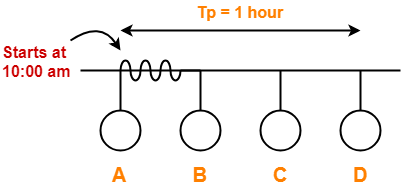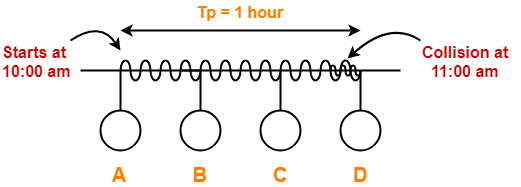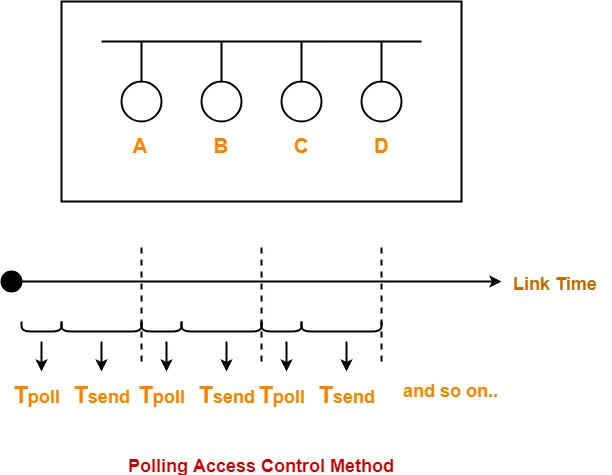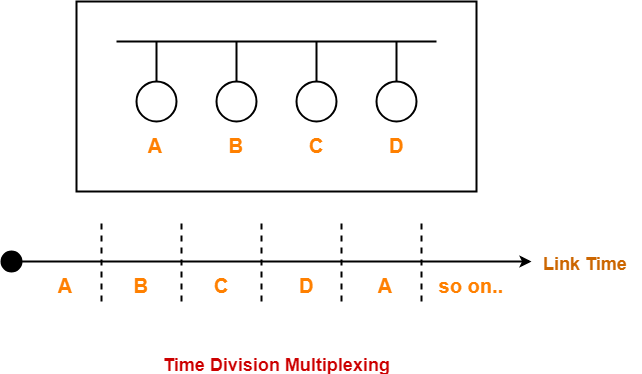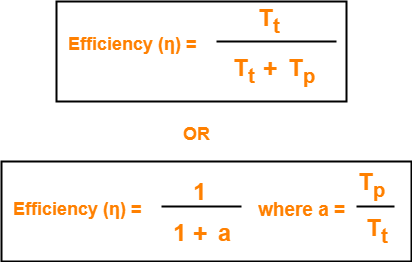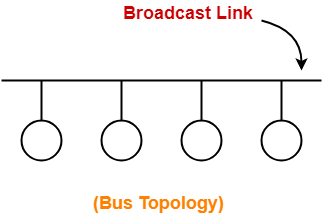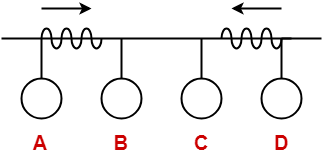Access Control in Networking-
Before you go through this article, make sure that you have gone through the previous article on Access Control.
We have discussed-
- Access Control is a mechanism that controls the access of stations to the transmission link.
- Broadcast links require the access control mechanism.
- There are various access control methods-
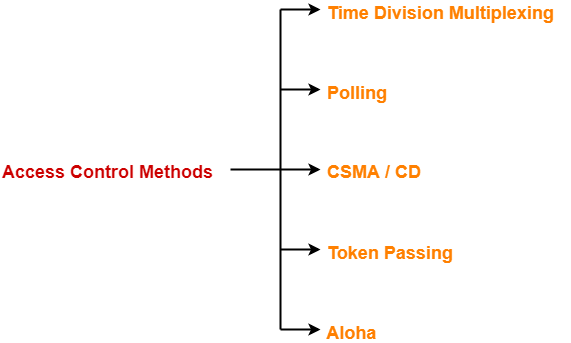
In this article, we will discuss about CSMA / CD.
CSMA / CD-
| CSMA / CD stands for Carrier Sense Multiple Access / Collision Detection. |
This access control method works as follows-
Step-01: Sensing the Carrier-
- Any station willing to transmit the data senses the carrier.
- If it finds the carrier free, it starts transmitting its data packet otherwise not.
How?
- Each station can sense the carrier only at its point of contact with the carrier.
- It is not possible for any station to sense the entire carrier.
- Thus, there is a huge possibility that a station might sense the carrier free even when it is actually not.
Example-
Consider the following scenario-
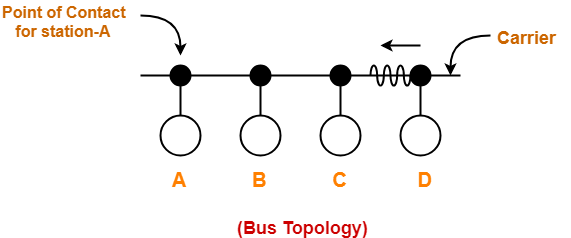
At the current instance,
- If station A senses the carrier at its point of contact, then it will find the carrier free.
- But the carrier is actually not free because station D is already transmitting its data.
- If station A starts transmitting its data now, then it might lead to a collision with the data transmitted by station D.
Step-02: Detecting the Collision-
In CSMA / CD,
- It is the responsibility of the transmitting station to detect the collision.
- For detecting the collision, CSMA / CD implements the following condition.
- This condition is followed by each station-
| Transmission delay >= 2 x Propagation delay |
Meaning-
According to this condition,
- Each station must transmit the data packet of size whose transmission delay is at least twice its propagation delay.
- If the size of data packet is smaller, then collision detection would not be possible.
Length Of Data Packet-
We know-
- Transmission delay = Length of data packet (L) / Bandwidth (B)
- Propagation delay = Distance between the two stations (D) / Propagation speed (V)
Substituting values in the above condition, we get-
L / B >= 2 x D / V
Thus,
| L >= 2 x B x D / V |
Understanding the Condition To Detect Collision With Example
(We are considering station D for the worst case)
|
Two cases are possible-
Case-01:
If no collided signal comes back during the transmission,
- It indicates that no collision has occurred.
- The data packet is transmitted successfully.
Case-02:
If the collided signal comes back during the transmission,
- It indicates that the collision has occurred.
- The data packet is not transmitted successfully.
- Step-03 is followed.
Step-03: Releasing Jam Signal-
- Jam signal is a 48 bit signal.
- It is released by the transmitting stations as soon as they detect a collision.
- It alerts the other stations not to transmit their data immediately after the collision.
- Otherwise, there is a possibility of collision again with the same data packet.
- Ethernet sends the jam signal at a frequency other than the frequency of data signals.
- This ensures that jam signal does not collide with the data signals undergone collision.
Step-04: Waiting For Back Off Time-
- After the collision, the transmitting station waits for some random amount of time called as back off time.
- After back off time, it tries transmitting the data packet again.
- If again the collision occurs, then station again waits for some random back off time and then tries again.
- The station keeps trying until the back off time reaches its limit.
- After the limit is reached, station aborts the transmission.
- Back off time is calculated using Back Off Algorithm.
CSMA / CD Flowchart-
The following CSMA / CD flowchart represents the CSMA / CD procedure-
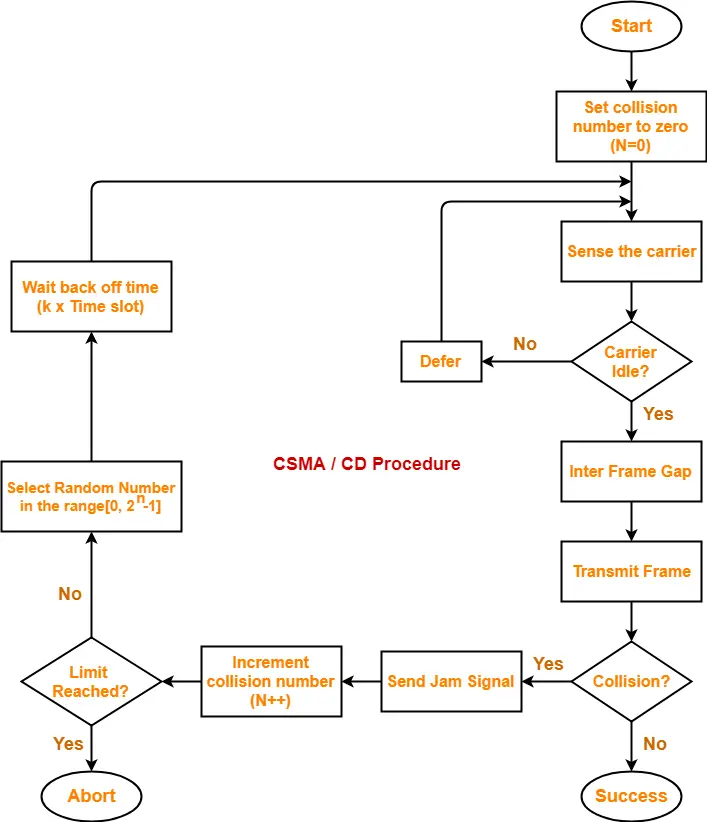
Efficiency-
| Efficiency (η) = Useful Time / Total Time |
Before a successful transmission,
- There may occur many number of collisions.
- 2 x Tp time is wasted during each collision.
Thus,
- Useful time = Transmission delay of data packet = Tt
- Useless time = Time wasted during collisions + Propagation delay of data packet = c x 2 x Tp + Tp
- Here, c = Number of contention slots / collision slots.
Thus,

Here,
- c is a variable.
- This is because number of collisions that might occur before a successful transmission are variable.
Probabilistic Analysis shows-
| Average number of collisions before a successful transmission = e |
Substituting c = e in the above relation, we get-
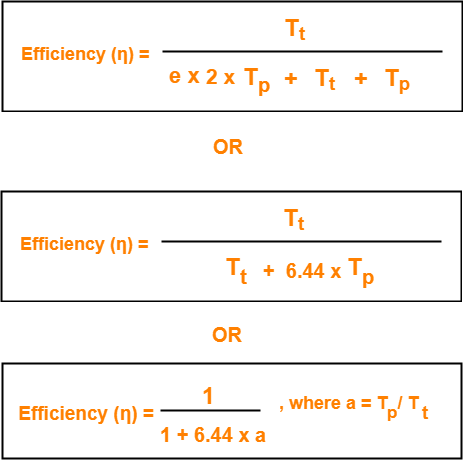
Probabilistic Analysis-
Let us perform the probabilistic analysis to find the average number of collisions before a successful transmission.
Consider-
- Number of stations connected to a CSMA / CD network = n
- Probability of each station to transmit the data = p

Transmission will be successful only when-
- One station transmits the data
- Other (n-1) stations do not transmit the data.
Thus, Probability of successful transmission is given by-

Now, let us find the maximum value of Psuccessful transmission.
For maximum value, we put-

On solving,
| At p = 1/n, we get the maximum value of Psuccessful transmission |
Thus,
(Psuccessful transmission)max
= nC1 x 1/n x (1 – 1/n)n-1
= n x 1/n x (1 – 1/n)n-1
= (1 – 1/n)n-1
| (Psuccessful transmission)max = (1 – 1/n)n-1 |
If there are sufficiently large number of stations i.e. n → ∞, then we have-

Number of times a station must try before successfully transmitting the data packet
= 1 / Pmax (Using Poisson’s distribution)
= 1 / (1/e)
= e
From here, we conclude-
Average number of collisions that might occur before a successful transmission = e
Important Notes-
Note-01:
- CSMA / CD is used in wired LANs.
- CSMA / CD is standardized in IEEE 802.3
Note-02:
- CSMA / CD only minimizes the recovery time.
- It does not take any steps to prevent the collision until it has taken place.
Important Formulas-
- Condition to detect collision: Transmission delay >= 2 x Propagation delay
- Minimum length of data packets in CSMA / CD = 2 x Bandwidth x Distance / Speed
- Efficiency of CSMA / CD = 1 / (1 + 6.44 x a) where a = Tp / Tt
- Probability of successful transmission = nC1 x p x (1-p)n-1
- Average number of collisions before a successful transmission = e
To gain better understanding about CSMA / CD,
Next Article- Binary Exponential Back Off Algorithm
Get more notes and other study material of Computer Networks.
Watch video lectures by visiting our YouTube channel LearnVidFun.
